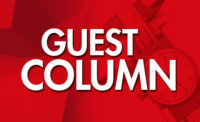I settled into my seat on my favorite airline (that I won’t identify here to prevent inadvertent promotion, but it has five letters and the best on-time performance). As I looked forward, a passenger standing in the aisle next to me quickly spun around, and nearly knocked me out. She carried a backpack with a heavy article hanging off of it, and it struck me in the head. I was thinking, “I need to write an article suggesting that flying requires training in self-defense,” then remembered that this has nothing to do with quality. No matter the quality of the airline, we are all in the same boat (or plane) when it comes to avoiding getting knocked out during boarding.
Then I looked down at the seat next to me, as yet unoccupied. There was an oversized postcard on it that said “Thank you.” I picked up the card and turned it around. To my amazement, there was a personal note from a member of the cabin crew to the occupant of that seat, a “Million Miler” on the airline. The note expressed appreciation for the passenger’s loyalty. I am not yet a Million-Miler so I didn’t get a card, but I wasn’t at all disappointed. Then, a well-dressed flight attendant stood next to me, looking down. “Mr. Lazarus?” he asked. “Yes,” I replied, thinking I was in some kind of trouble. “Mr. Lazarus,” he repeated, “I just want to thank you for being a Platinum Medallion member. We appreciate your loyalty. Have a nice flight.” I was delighted at the recognition, and perhaps a little embarrassed.
In “No Apology Necessary (October 2019),” I wondered who at this airline thought it was a good idea to produce laminated bookmarks that said basically “we’re sorry we screwed up and that your flight is delayed.” Now I am wondering who thought that the “thank you” cards were a good idea, because they are!
While I usually use these columns to complain about poor quality (see any of my previous articles), the thank you cards reminded of the Kano Model which is often included in the Lean playbook, or other programs that teach quality. The Kano Model is an important tool for quality professionals that can influence the product roadmap, because it helps to identify those “delighters” that customers will value but often not expect.
On arriving at the rental car facility, I spoke to an agent and apologized that I was early in picking up my vehicle, an economy car, because my flight was also early. He looked into the computer and told me that my car was waiting for me outside. When I got there, a brand-new, high-end Mercedes SUV was waiting for me. The car was fully loaded, including features that I’ve never experienced before. This was most definitely not an economy car, but since my rate was guaranteed, it was provided me at no extra cost. I was delighted.
During this trip, my mind was on my daughter who, having just entered university, was sick for the prior 10-day period, missing school and feeling miserable. It was impossible for me to get out of my mind all the implications of her illness (missed homework, falling behind, and the potential for a diminished immune system to invite other problems), and I found my mind wandering when I should have been concentrating on driving a foreign vehicle in a foreign town. I was about to leave my hotel’s parking lot to meet friends for dinner, when things could have gone horribly wrong.
As I reversed the car quickly out of its spot, the car automatically slammed on the brakes. It was so sudden that I was certain I hit something and my pulse started to race. I looked into the rear-view mirror to see another car passing behind me. I was so consumed with my daughter’s welfare that I wasn’t paying attention to the situation: I was “unconsciously incompetent.” The rental car saved me from an embarrassing accident.
What we know from the Kano Model is that many product features that begin as “delighters” will migrate into the mainstream of all competitive products (think about hotel coffee makers, and thank the hotel chain that started offering them first). So, you ultimately have a choice: lead the market with delighters of your own, or be forced into compliance just to keep pace.
When you work in quality you are likely hypersensitive to what separates world-class companies from those that fall short, especially when you are traveling. It seems that whenever I leave town, I am presented with a range of experiences where quality, both good and bad, are immediately recognizable, and then there is the occasional delighter. What delighters can you advocate for in your product line?
It is the delighters that separate world class companies from the rest of the pack. So, if you feel you need to calibrate your own quality radar, do your customers a favor, and get out of town.


